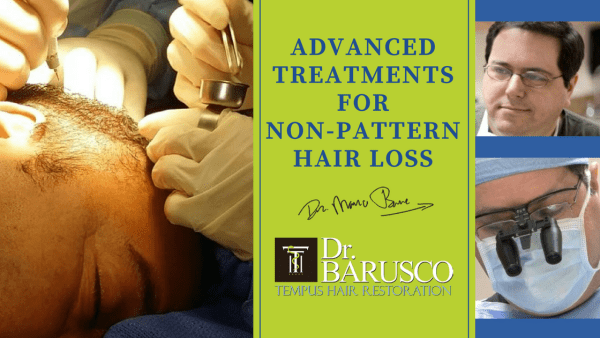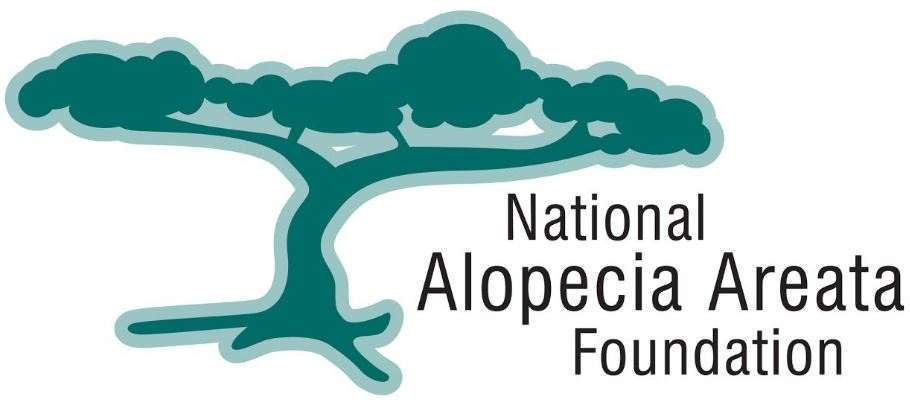
Non-patterned Hair Loss – Causes and Treatments
The stages of hair loss typically follow one of several common patterns – from a receding hairline to the classical horseshoe to the central bald spot. While genetics is the leading cause of male pattern baldness, some types of hair loss occur outside of this category. Hair falling out in patches or during a relatively short time period can have a number of causes, making non-patterned hair loss challenging to treat, as well as frustrating and troubling to those suffering from it. Learning to identify the various characteristics of non-patterned loss can lead to a quicker diagnosis and effective treatment.
As cited by WebMD, heredity accounts for 95 percent of all the cases of alopecia (baldness) in the United States. The remaining five percent can be due to a number of factors, including:
Diet – Unusually high levels of vitamin A or low levels of iron or protein. Iron is essential for the production of hair protein.
Illness – Thyroid disease, severe infection or flu.
Medications – Drugs used to treat hypertension (high blood pressure), heart problems, depression or gout; birth control pills.
Hormonal imbalances – Changes in female hormone levels during pregnancy or menopause. Also, polycystic ovarian syndrome (PCOS) is a hormonal disorder that can cause hair loss by increasing levels of testosterone and dihydrotestosterone (DHT).
Stress – One of the most common causes of non-patterned hair loss, stress can trigger production of higher androgen levels. Androgens can attack the hair growth cycle and shorten it, which can cause hair loss.
Recognizing Alopecia Areata
Often mistaken as stress-related hair loss, alopecia areata is an autoimmune disorder that causes the immune system to attack hair follicles. According to the American Academy of Dermatology (AAD), alopecia areata can cause different types of hair loss: alopecia areata (hair loss in patches), alopecia totalis (total hair loss on the scalp) and alopecia universalis (hair loss on the entire body).
The AAD notes that alopecia areata in all of its variations is not due to nerves, and most often occurs in otherwise healthy people. Hair typically grows back, but can fall out again.

The National Alopecia Areata Foundation (NAAF) is a resource for those living with this condition. The NAAF states that although there are currently no treatments that work for everyone, some are effective for some people, depending on which type of alopecia areata is involved, the patient’s age and the extent of hair loss.
The main goals of treatment are to block the immune system’s attack and/or to stimulate hair regrowth. According to the NAAF, this can be effective, especially for those with less than 50 percent hair loss. For those with greater than 50 percent loss, oral and topical medications are available, as well as phototherapy (light treatments).
Recognizing Traction Alopecia
Traction alopecia is a type of hair loss that occurs over time. It is caused by putting the hair under constant strain or tension, and usually results from wearing hair in very tight ponytails, pigtails, tight braids or cornrows. As more hair falls out, sufferers tend to attempt to mask the issue through weaves and hair extensions – which sets up a vicious cycle that worsens the condition.
This was the case with J.D. – a patient of Dr. Marco Barusco who sought treatment for her traction alopecia, made worse by the weaves she used to create the appearance of a full head of hair. In her job as a pharmaceutical representative, presenting a polished, professional image is essential, which led J.D. to research hair restoration specialists before scheduling an appointment at Tempus Hair Restoration. After a successful treatment program, J.D. is now proud to let her natural hair represent her self-confidence to the world. And she is not wearing tight ponytails anymore.
Treatments For Non-Patterned Hair Loss
Unlike male and female pattern baldness, the cause of each individual case of non-patterned hair loss is different. A diagnosis by a licensed physician who has experience with hair loss needs to be made in order for a course of treatment to be planned. While you may suspect a cause, attempting to treat non-patterned hair loss without a diagnosis can make the condition worse – or at the very least, delay effective treatment and the desired outcome of healthy hair.
Dr. Barusco has over 20 years of experience treating all types of hair loss – including non-patterned. His professional credentials include: Diplomate and Past President (2017) of the American Board of Hair Restoration Surgery; Assistant Professor of Surgery – University of Central Florida College of Medicine; Fellow of the International Society of Hair Restoration Surgery (ISHRS) and Fellow of the American Academy of Cosmetic Surgery (AACS).
We offer the latest, most advanced treatments available for non-patterned hair loss. Our blog post, “Non-surgical Treatments for Hair Restoration,” discusses prescription medications and other treatments our practice utilizes, depending upon the individual patient’s case.
If you are suffering with non-patterned hair loss, schedule a free consultation with Dr. Barusco. Unlike many other hair restoration practices, Dr. Barusco conducts all consultations (both in-office and virtually) himself, and performs all procedures.
Should you be reading this article outside of the areas served by our 14 offices throughout Florida, we can make arrangements for a virtual consultation with Dr. Barusco. For your convenience, consultations are offered in English, Spanish and Portuguese. Dr. Barusco and our staff look forward to meeting you, and helping you get the right treatment for your type of hair loss.

